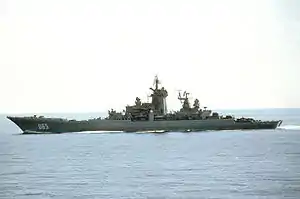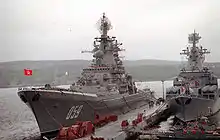Russian battlecruiser Kirov
Kirov is the lead ship of the Kirov class of nuclear-powered missile cruisers. Originally built for the Soviet Navy, it was one of the biggest and most important surface combatants of the Russian Navy. It is similar in displacement to a World War I battleship. Although commissioned as a missile cruiser, Kirov's size and weapons complement have given her the unofficial designation of a battlecruiser throughout much of the world. The appearance of the Kirov class was a significant factor in the U.S. Navy recommissioning the Iowa class.[1] She was named after a Project 26 cruiser (named after Sergey Kirov, a Bolshevik hero).
 Kirov c.1983 | |
| History | |
|---|---|
| Name: | Kirov |
| Namesake: | |
| Builder: | Baltiysky Naval Shipyard, Leningrad |
| Laid down: | 27 March 1974 |
| Launched: | 26 December 1977 |
| Commissioned: | 30 December 1980 |
| Out of service: | In reserve, 1990 |
| Renamed: | Admiral Ushakov, 1992 |
| Status: | Laid-up, to be scrapped. |
| General characteristics | |
| Class and type: | Kirov-class battlecruiser |
| Displacement: | 24,300 tons Standard, 28,000 (Full load) |
| Length: |
|
| Beam: | 28.5 m (94 ft) |
| Draft: | 9.1 m (30 ft) |
| Propulsion: |
|
| Speed: | 32 knots (59 km/h) |
| Range: |
|
| Complement: |
|
| Sensors and processing systems: |
|
| Armament: |
|
| Armour: | 76 mm plating around reactor compartment, light splinter protection |
| Aircraft carried: | 3 Kamov Ka-27 "Helix" or Ka-25 "Hormone" |
| Aviation facilities: | Below-deck hangar |
History
She was laid down on 27 March 1974, at the Baltiysky Naval Shipyard in Leningrad, launched on 26 December 1977, and commissioned on 30 December 1980, part of Soviet Northern Fleet. When she appeared for the first time in 1981, NATO observers called her BALCOM I (Baltic Combatant I).
Her first long voyage was in 1984 to the Mediterranean Sea.
Heavy cruiser's second and final long voyage happened between December 1, 1989 - February 17, 1990 in the Mediterranean Sea. During the deployment, she suffered a reactor malfunction. Afterwards, she was placed in reserve.[2][3]
For political reasons, Kirov was renamed Admiral Ushakov after the 18th-century admiral Fyodor Fyodorovich Ushakov in 1992, but subsequent photos suggest that it has since reverted to its original name. An overhaul was started in 1999, but the ship was written off in 2001 and was slated to be dismantled in 2003.[3][4]
In 2010, the Russian navy again announced new plans for an overhaul of the cruiser. At the time, the plan was to modify and reactivate all of the Kirov battlecruisers by 2020. However, in 2012 it was reported that Admiral Ushakov and Admiral Lazarev would not be overhauled due to being in a state of "beyond repair".[6]
Armament
This ship had an armament of missiles and guns as well as electronics. Its largest radar antenna is mounted on its foremast and called "Top Pair" by NATO. Kirov's main weapons are 20 P-700 Granit (SS-N-19 Shipwreck) missiles mounted on deck, designed to engage large surface targets, and air defense is provided for with 12 S-300F (SA-N-6) launchers with 96 missiles, two Osa-M (SA-N-4 Gecko) with 40 missiles and the Kashtan CIWS air-defence missile/gun system.
Other weapons are the automatic 130 mm AK-130 gun system, 30 mm AK-630, 10 torpedo/missile tubes, Udav-1 (SS-N-14 Silex) with 40 anti-submarine missiles and the two RBU-1000 six-tube launchers.
Fate

Kirov suffered a reactor accident in 1990 while serving in the Mediterranean Sea. Repairs were never carried out, due to lack of funds and the changing political situation in the Soviet Union. She may have been cannibalized as a spare-parts cache for the other ships in her class.
In June 2004, the name Admiral Ushakov was transferred to the Sovremennyy-class destroyer Besstrashnyy. In September 2004, it was revealed that the Severodvinsk-based Design Bureau Onega had been tasked with developing the dismantlement project for the cruiser, currently moored at the Severodvinsk Zvezdochka plant. According to the Zvezdochka plant, dismantlement of the former Admiral Ushakov would cost $40 million.[7] This plan was halted when the Russian navy planned to bring her back to service. This now seems unlikely and Zvezdochka shipyard CEO Vladimir Nikitin foresees dangers removing the spent nuclear fuel from the vessel's two reactors, it having never been moved or changed in 34 years.[6][8]
In April 2019, Russia decided to scrap and recycle the Admiral Ushakov in 2021.[9]
In popular culture
- In the film Threads, Kirov collides with USS Callaghan in the Persian Gulf.
See also
- Soviet cruiser Kirov, a Kirov-class cruiser, lead ship of a Soviet 1930–1940s class of conventional cruisers
- Admiral Ushakov (warship), for other ships named for Fyodor Fyodorovich Ushakov
References
- Middleton, Drew (13 March 1981). "Pentagon likes budget proposal, but questions specifics". The New York Times. p. A14.
- http://nvo.ng.ru/armament/2009-09-25/8_kreiser.html
- "Project 1144.2 Orlan Kirov class Guided Missile Cruiser (Nuclear Powered)". GlobalSecurity.org. Retrieved 17 July 2015.
- "Northern fleet vessels". Archived from the original on 3 December 2012. Retrieved 18 February 2009.
- Pettersen, Trude (27 September 2012). "Only one nuclear cruiser to be modernized". Barents Observer. Retrieved 17 July 2015.
- "Project 1144.2 Orlan - Kirov class - Guided Missile Cruiser (Nuclear Powered) - class article". GlobalSecurity.org. Retrieved 17 July 2015.
- Nilsen, Thomas (10 January 2014). "Shipyard director fears radiation accident". Barents Observer. Retrieved 17 July 2015.
- "Russia decides to scrap its legendary nuclear-powered battlecruisers to save money". Defence Blog. 22 April 2019. Retrieved 23 April 2019.